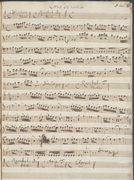A RISM Internship: Report from the Central Office in Frankfurt
Ulrike Schädel
Thursday, June 21, 2018

The following is by Ulrike Schädel, who was an intern in the Central Office in the winter/spring of 2018.
I encountered RISM for the first time in the course of musicological research. By chance, I happened to hear about an opportunity to complete a five-week internship at RISM.
Everything was prepared for me in the Central Office: a desk in the office of the assistant director, Martina Falletta. I received training from her and other RISM staff and I also took part in the staff meetings. The team invested a lot into my internship and I received more than I was able to give in five weeks. I was very touched by this appreciation of a future musicologist.
Currently, the RISM database holds descriptions of over 1.1 million historical musical sources that are held in libraries, archives, churches, schools, and private collections worldwide. The RISM online catalog has a search box for music incipits, which is most helpful for music manuscripts. The catalog has over one million incipits. They are useful for identifying differences between compositions. An incipit consists of at least two measures of the beginning of a piece, or at least as many as are necessary for clear identification. For a multimovement work, this often means a lot of opening measures.
My first task was to input incipits using the Plaine & Easie Code. I usually used a digitized copy of a manuscript, such as a Telemann cantata from Brussels. To do this, it was important to be able to read German Kurrent handwriting and different historical clefs, especially the C-clefs. While both of these skills got easier and faster with a bit of practice, more experience was needed to examine and identify the individual parts for a manuscript and their relationship to the entire work. The RISM staff can figure this out just by flipping through the images. Lacking experience, I put together a table that helped me visualize the structure. Some digitized manuscripts were written by multiple copyists, whose idiosyncrasies I got used to over time. For this work, I relied on my own intuition a lot. Once the incipit was finished, I could mentally hear the music. The rooms of the Central Office are very quiet. Telephones were hardly used. The work atmosphere was often medatitive.
There are around 30,000 composers in the RISM database, including Evermod Groll. The somewhat random discovery of a book about Groll by Franz Lederer in the university library led to my adding the catalog of works numbers for this composer to his sources in RISM. Groll lived between 1755 and 1810 and was a priest and Kapellmeister in the Premonstratensian order. Lederer’s book is somewhat obscure. The catalog of works also mentions the locations of additional prints and manuscripts. The KVK catalog (Karlsruher Virtueller Katalog) listed two further copies of prints. The WorldCat database, to which libraries worldwide contribute, was also useful.
The Central Office is also responsible for public relations and outreach. It is important to communicate that RISM exists and what it is, and to attract new users. In additional to usual PR work, social networks such as Facebook, Twitter, and YouTube play a role. There is a lively RISM page on Facebook with an international community and regular contributions from around the world. The RISM website was launched in 2010. It features a blog with relevant topics for users, such as news of new sigla, the addition of a catalog of works, and notifications of new publications. There is also room for creativity, such as the 2016 RISM Bird Count, which listed birds named on sources in the RISM database. I wrote an article to commemorate the 100th anniversary of Claude Debussy’s death.
At first, I found it difficult to transition from studying to the working world and fitting in with the demands of an office. Entering data in the RISM database itself required careful work and patience. Over time, I recognized the importance of this activity. It was valuable to me to be able to contribute something to it. Initially, I found the organization of RISM to be strangely institutionalized in contrast to the idealism of the idea. But it creates space for the attentive cultivation of musical culture as historical heritage, naturally networked with scholars in over 35 countries around the world, beyond war and politics.
Image: Georg Philipp Telemann, Das Blut Jesu Christi, Universitätsbibliothek Johann Christian Senckenberg, Frankfurt (D-F Ms.Ff.Mus 820), RISM ID no. 450003788.
Share Tweet EmailCatégorie: Nouveau au RISM

